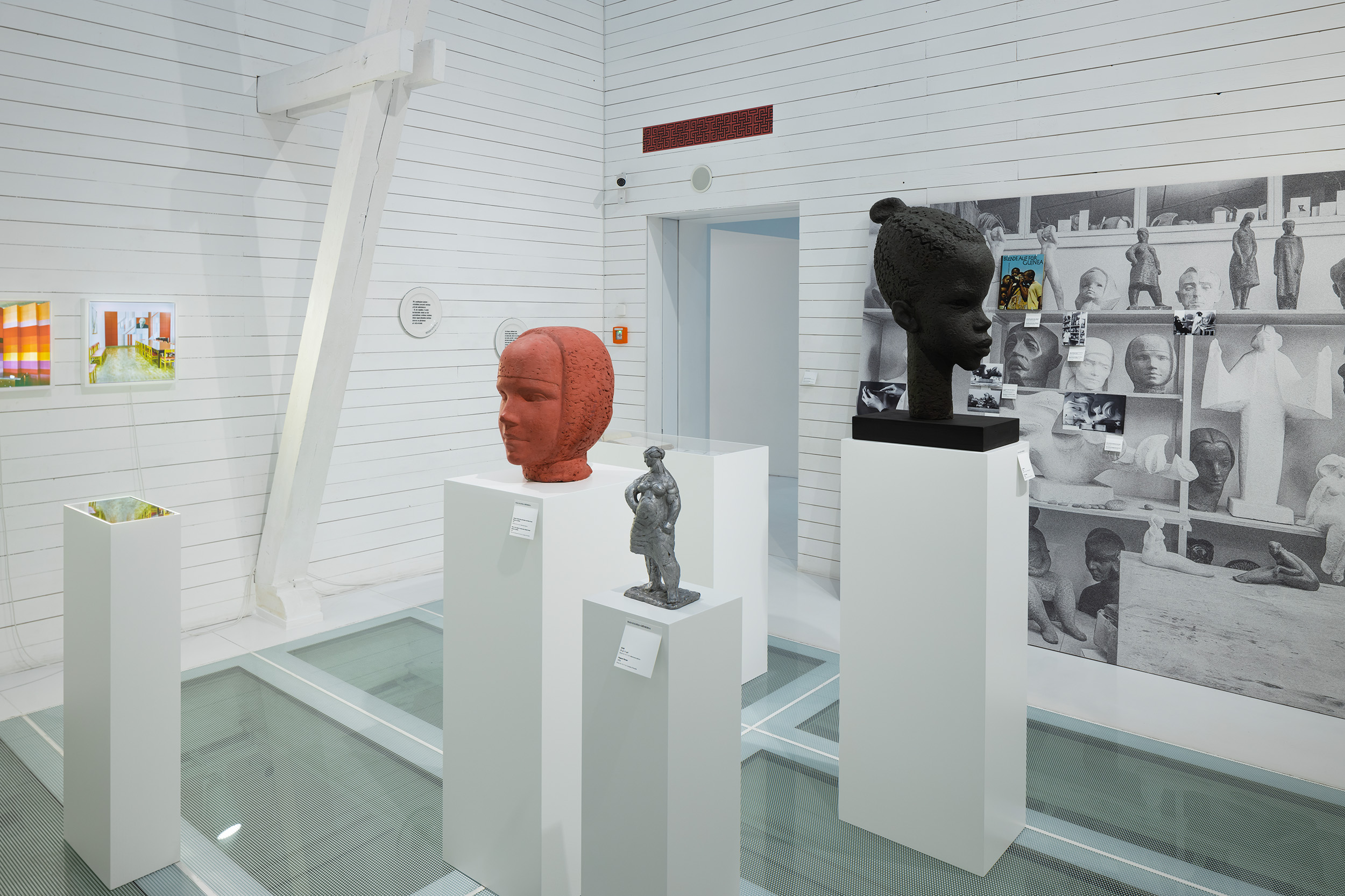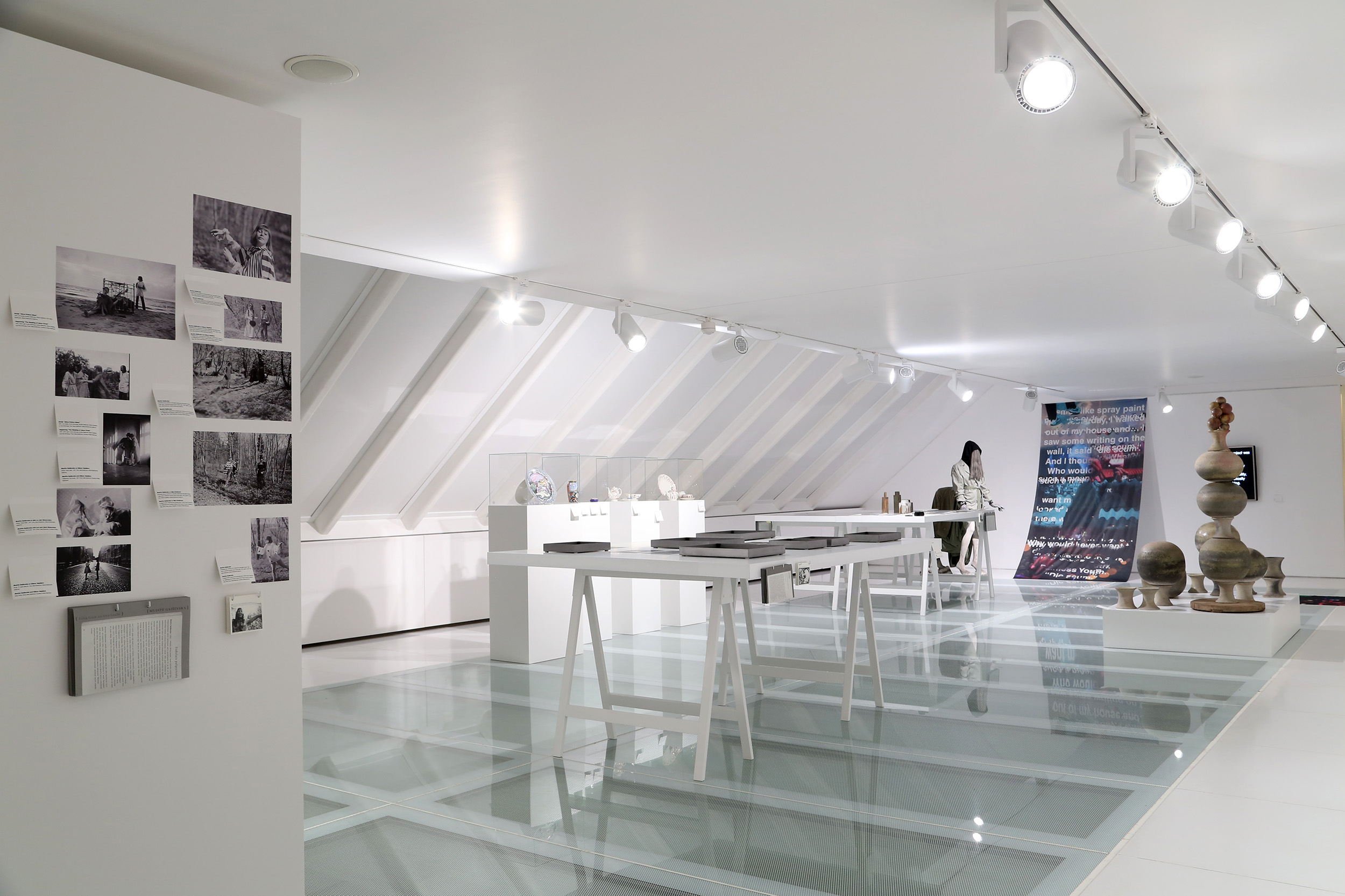
Adam Mazur: Let us begin with the title of your exhibition – “I Remember, Therefore I Am. Unwritten Stories: Women Artists’ Archives” – what does it mean to you?
Andra Silapētere: The phrase in the title “I Remember, Therefore I Am” comes from one of the exhibitions protagonists – theatre director and writer Mudīte Gaiševska and her autobiography. She wrote the text in 2019 collecting different episodes of her life saving them from disappearing from her own as well as others’ memory. In the introduction of the autobiography she reflects on memory and the fact that collective or individual memory is impacted by various social processes. She periphrases Descartes famous saying, “I think, therefore I am” and manifests herself as a person that exists threw this remembrance act – remembering her life and creative work. For me, this thought was very important while thinking about woman artist histories that throughout different periods and contexts have been marginalized, and now with our research (remembering) get back their voices. Exhibition tries to restore these stories, unknown or forgotten, and poses questions like how can we escape the situation when certain groups of society are neglected and marginalized?
Why is remembering so important to you?
In the exhibition, remembering relates to questions of solidarity, tolerance and equality in our society. It questions our knowledge of certain periods and ways in which we have constructed “truth”, and also continue to reproduce from book to book or from exhibition to exhibition. We can observe that as a society we tend to lose knowledge or erase from our collective memories’ “evidence” about people, events or experiences traumatic or happy. Memory is interspersed with blank spots which makes one pose the question, why do we tend to forget certain narratives or stories?

‘I Remember, Therefore I Am. Unwritten Stories: Women Artists’ Archives’, exhibition view at Latvian National Museum of Art, photo: Ansis Starks
For instance, the feminist movement did not start yesterday. But because of the problem zones that feminism illuminates, that are not so comfortable to the ears of society, we do not evenly distribute knowledge about these issues from one era to another, from one human to another, almost like hiding. We also see reasons for such amnesia that lead to ideas formulated by political, economic and religious contexts which tend to define limits of our memory or shape it in the way that suits the rhetoric of the powerful. And these contexts are dominated by heteronormative and patriarchal societal structures that also shape writing of history, whether in books or in museum collections.
I was happy to invite Liliana Piskorska for this exhibition. Her work “Source Book” distinctly illuminates these questions. Her installation, through different media: essay, images and object, tells firstly, a fascinating story, but, secondly, shows irrefutable evidence to such “memory loss” that is impacted by social and political contexts. Liliana turns to the history of lesbians, who are to remain unknown due to our recant past when such discourses had to remain silenced as well as today with the far-right politics in present-day Poland. She writes a “Sourcebook” bringing to the fore lesbian histories in Poland as a departing point taking the story of Polish writer Sławomira Wałczewska. In 1974 she wrote to Kate Millett, an American feminist and activist, and posed a question about feminism and the ways of practicing it, as such knowledge was unavailable in Poland at the time. This, in turn, led her to accumulate sources and news that could increase this knowledge, and this is what Liliana is trying to do through her work now to increase the knowledge of lesbian histories.
If we could change such structures, would that help to better shape today and project different futures that could avoid crises like those we have experienced this year, and the more general progression of violence, racism, criticism of gender issues, ecological crisis, economic inequality?

‘I Remember, Therefore I Am. Unwritten Stories: Women Artists’ Archives’, exhibition view at Latvian National Museum of Art, photo: Margarita Ogoļceva
How do you write stories of semi-forgotten women artists? In what way is this process different from a similar research and archival practice focused on men?
The departure point of this research was understanding the dominating methods and interpretations that have been and are still used in both broader historical writing processes and local nuances in these processes. We see them not only through canons written down in history books, but also museum collections and the ways museums work with these collections. And for these reasons, a feminist approach to history serves as a method, intervention, and operation, helping to reveal more about our past and to find ways of expending our understanding of time. For instance, how have women’s social roles like, mother, wife, lover, and teacher worked together with bodily experiences like birth, menstruation, and abortion, to influence artistic production? What was important to woman artists? What were their passions, interests etc.? Why we do not see these narratives in broader historical context?
No matter the focus of the research, it is important to understand the context. In the case of the woman artist, it is domination by the patriarchal society. And through this structure, society has marginalized not only women, but the same can be said about the LGBT community, race, diaspora. Only in the last decades have we started to have a stronger awareness of it, even considering Eastern Europe and its recent past we have to admit that these questions still are considered as sensitive.
In your research and curatorial practice, you seem to be revolving around a question of memory and history. How do you understand these two concepts?
I am trained as an art historian and that serves as an important backbone to my curatorial praxis. A lot of my curatorial work relates to the Latvian Centre for Contemporary Art (LCCA) and its projects that deal with processes in the Baltics as well as Eastern Europe. Our projects grow from the need to revisit our recent past and think of new ways of how we can read our history, and how can that build a better understanding of today. It serves as a tool in understanding present social and political events, both locally and globally.
At the LCCA we feel that we must stimulate the local art historical discourse, opening new ways of interpretations. One of the ways we do this usually is based in our approach to curatorial work, which corresponds directly with art history writing. I think that we have developed this mentality from the archive of the contemporary art that we house, and it serves as an important reference for how we consider the contemporary. For instance, now my colleagues Leva Astahovska and Margaret Tali (EE) have curated an exhibition “Communicating Difficult Past” where contemporary artists work with different regional traumatic experiences in our recent past. It is a fascinating analysis of our history, offering this broader context that we tend to exclude today.

‘I Remember, Therefore I Am. Unwritten Stories: Women Artists’ Archives’, exhibition view at Latvian National Museum of Art, photo: Ansis Starks
Your exhibition is presenting historical figures as well as a selection of contemporary female artists, whom did you invite and how would you describe the present-day artist’s perspective on history and memory?
By re-examining events in Latvia and Eastern Europe in the second half of the 20th century, which are marked by the Soviet period, the exhibition was developed in colloboration with ten researchers. They turned their attention to different artistic strategies related both to the alternative culture and attempts at diversifying the language of art and the range of interests of the official art scene. The central protogonists of the exhibition are Rita Einberga (1921–1979), Laima Eglīte (1945), Maija Eliase (1924–1991), Mudīte Gaiševska (1935), Ruta Kreica (1946), Rasa Kalniņa-Grīnberga (1936) and Olga Neimane-Kataņeva (1908–2001). Whereas a new body of works were created for the exhibition by contemporary artists Anni Puolakka, Marta Trektere, Evita Goze, Rasa Jansone and Liliana Piskorska, who each outlined different aspects of feminism, gender and sexuality in present-day context. For the exhibition it was important to built colloborations with artist whose work could support, expend and contextualise the work of historical personalities. This kind of colloboration brought to the fore questions and interpretations that helped to understand not only historical nuances, but as well as todays feminist struggle.
In an introductory text you have stressed the importance of collective work, why do you think it is so fundamental in case of women artists?
The idea for the collective research on this project grew out of the Arton Foundation project “Unwritten Stories: Woman Artist Archives Online” where LCCA is a partner. It maps and contextualises women artists heritage through research in Latvia, Poland, Croatia and Slovenia. Part of our research activities are opened to a broader circle of researchers who are interested in woman artist histories. In the case of the LCCA I opened the participation possibilities to people from different backgrounds, that are not only related to art. We had a team that consisted of artists, researchers, historians, writers, culture workers, and journalists. It formed unbelievably beautiful dynamics and exchange of knowledge and thoughts. Through this collaboration we wanted to understand how and what we can learn when we combine our skills and experience, as well as the different approaches to testimonies from our past which we can gain from working together.
The collaboration and togetherness where different voices are heard, nurtured, embraced, has its roots in feminist approaches to contemporary struggles on the economic and ecological levels. We see that through the problems society is facing today we must think about collective care strategies as endeavour them as ways of being. These have become important ideas which can help to restructure the dominant patriarchal and heteronormative societal structures.
The exhibition is a part of the Not Yet Written Stories – Women Artists’ Archives Online, an international research project funded by Creative Europe, in which LCCA collaborates with the Arton Foundation in Warsaw (leader of the project) and the partners: SSCCA-Ljubljana and Office for Photography in Croatia. The aim of the project is to include the works of women artists into public discourse about visual arts in order to avert their further discrimination and mostly elimination from the European history of art.
Imprint
| Artist | Rita Einberga, Laima Eglīte, Maija Eliase, Mudīte Gaiševska, Ruta Kreica, Rasa Kalniņa-Grīnberga, Olga Neimane-Kateņeva, Anni Puolakka, Marta Trektere, Evita Goze, Rasa Jansone, Liliana Piskorska |
| Exhibition | I Remember, Therefore I Am. Unwritten Stories: Women Artists’ Archives |
| Place / venue | Latvian National Museum of Art, Riga, Latvia |
| Dates | 14 November 2020 – 24 January 2021 |
| Curated by | Andra Silapētere |
| Website | www.lnmm.lv/en/ |
| Index | Adam Mazur Andra Silapētere Latvian Centre for Contemporary Art |
